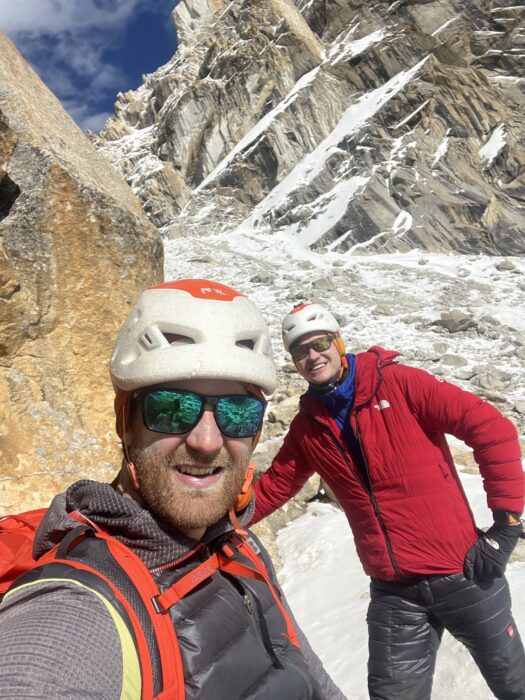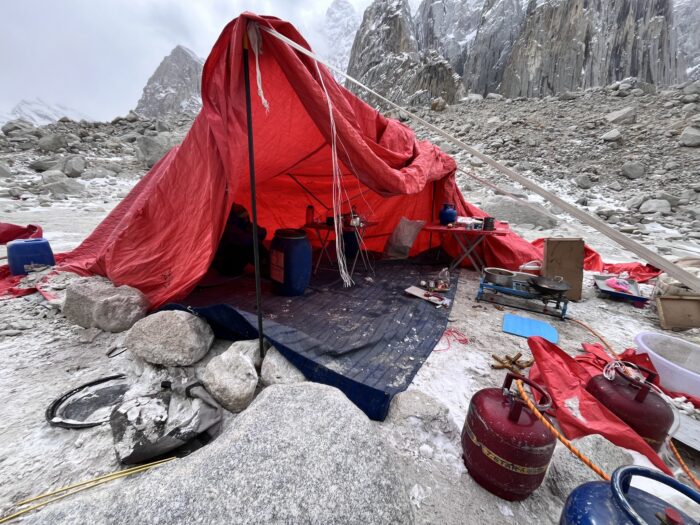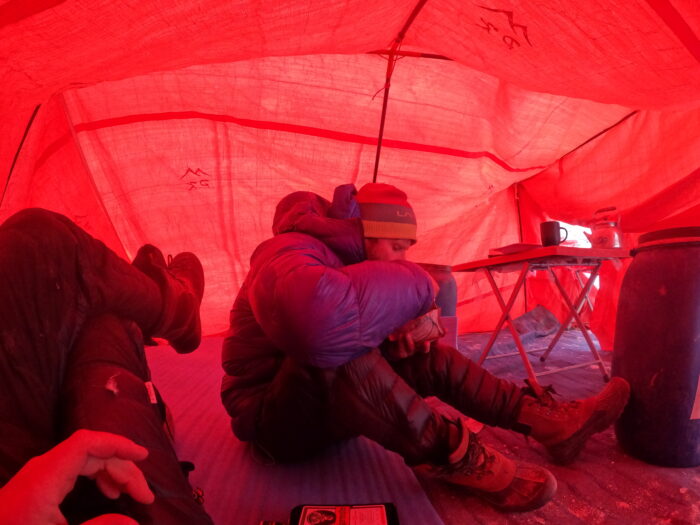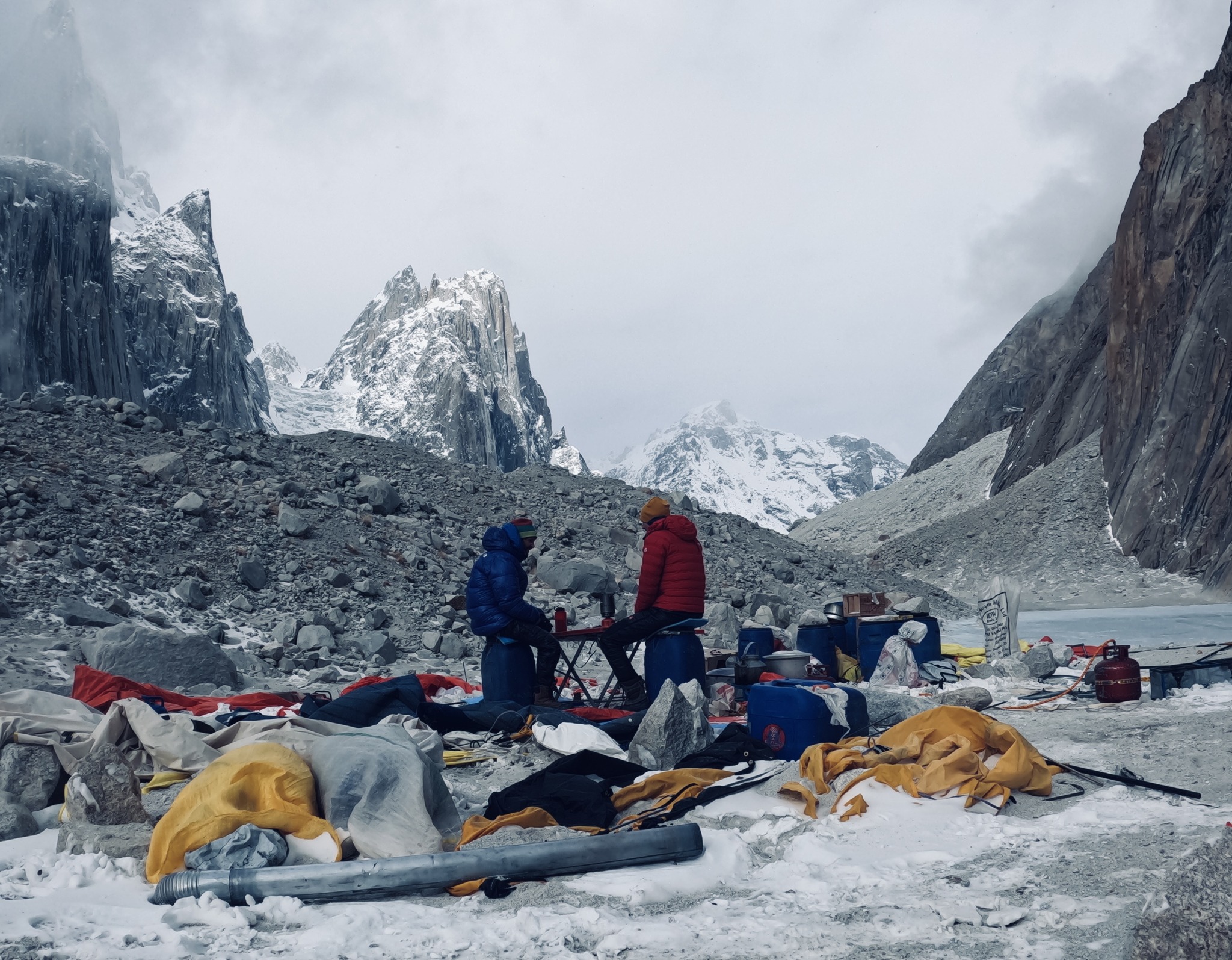Maciej Kimel and Michal Krol of Poland expected extreme conditions climbing the British route on Trango Tower in winter, but their attempt ended even before touching the wall, Kimel told ExplorersWeb in an exclusive interview. The problem: After a windstorm, they say their outfitter left them alone in a destroyed Base Camp.
This was Kimel and Krol’s second attempt at a first winter ascent of the Karakoram’s Trango Tower. In 2022, they went with Janusz Golab, but bad weather and avalanches pushed them back after eight days on the face. This year, they went for the same route but opted for a lighter, faster approach.
A promising start

Approaching the base of the face, when things still looked good. Photo: Polski Himalaizm Sportowi
“We went in a small team and kept things to a minimum,” Kimel, speaking on behalf of the pair, told ExplorersWeb. “Instead of a large portaledge, we took a small, two-person one, assuming that we would move the bivouac higher each day.”
Everything started well, with a short three-day trek to Base Camp in good weather.

The Trango Tower on a sunny winter day. Photo: Maciej Kimel
“On our first outing, we carried all our stuff up the wall to an altitude of 5,200m,” Kimel said. “We also managed to fix rope up the last 300m before the route, because there was a high risk of avalanches.”
The team climbed a little further, to 5,300m, and deposited some gear just below the start of the British route. “We saw the first pitches but did not climb a single meter.”
A gale strikes Base Camp
“In the [first] three days, we went up and down three times, carrying 70kg to the base of the wall,” said Kimel. “On the fourth day, gale-force winds swept Base Camp. It most affected the mess tent, which was not prepared for winter conditions.”
The Base Camp staff had no ropes or any way to secure the tent, nor were they properly equipped.
“It was extremely cold and yet they wore ordinary [sneakers],” Kimel said. “The situation soon got dire, so Michal and I decided to retreat lower down. We descended 400m to 3,800m, and so did the BC crew. We waited there for two days, with no food.” See a video of the storm here: IMG_8904
When conditions improved, they returned to Base Camp to find it completely destroyed.
“Before we retreated two days before, I asked the cook to secure the kitchen and pack everything in the barrels, but he didn’t. When we returned, everything lay scattered around Base Camp.”

The wrecked Base Camp. Photo: Polski Himalaizm Sportowi
“We had no more mess tent, and all the food the agency had provided was ruined and scattered around, picked at by the crows.”
Left for days
“When our cooks saw the scene, they said they had nothing to do there and departed down the valley, leaving us without food, electricity, and heat for four days, at temperatures down to -30ºC. To this day, I don’t understand why they left us there.”

The remains of the mess tent. Photo: Polski Himalaizm Sportowi
Kimel and Krol say they contacted their outfitter daily and that they were promised replacement staff, supplies, and equipment “the following day.” Nothing came.
“Finally, after six days — two at 3,800m and four more in the flattened Base Camp — two porters came in the evening with a moldy tent and some vegetables. We still had no heat and no generator. We no longer had the strength to wait for more promises.”
While alone in Base Camp, they survived by using the food and fuel they had stocked for the climb.
“If it wasn’t for the problems with Base Camp, we would have tried climbing,” they said. “The wall looked in very good condition, mostly dry, with only a little snow in the dihedral.”

Waiting for resupplies. Photo: Maciej Kimel
No beginners
The climbers said they had hired that particular outfitter in the past. “In 2022, we also had some problems with the generator and a mess tent, but it looked better than the one we were provided this year.”
Maciej Kimel is not new to the Karakoram: in addition to the 2022 winter attempt, Kimel did some first ascents on Shimshal’s 6,000’ers on an expedition that also included Adam Bielecki, Janusz Golab, Michal Czech, and Wadim Jablonski. Kimel and Jablonski also opened a new route on Chobutse in Nepal last fall.

Left to right, a bummed Kroh and Kimel. Photo: Polski Himalaizm Sportowi
As for the expedition outfitter — read the report by Polski Himalaism Sportowi for further details — it is one of the biggest in Pakistan, but this was not its first controversy. This same outfitter also sent high-altitude porter Muhammad Hassan to K2’s upper sections without proper gear or experience. Hassad died at the Bottleneck while dozens of climbers passed over him on their way to the summit. Local authorities later banned the agency from the 8,000’ers for two years.
ExplorersWeb has contacted the agency’s owner for comments, but we have not yet received a reply.

The remains of the mess tent. Photo: Polski Himalaizm Sportowi






